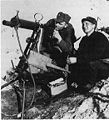File:Arquebus Krigshistorisk Museum Norway WW2 Norwegian army Hæren soldiers fighting German invation April 1940 Colt M-29 water-cooled heavy machine gun miltraljøse Uniforms M1914 mountain-grey red piping ski caps mannequins etc (2023) A.jpg
From Wikimedia Commons, the free media repository
Jump to navigation
Jump to search

Size of this preview: 800 × 600 pixels. Other resolutions: 320 × 240 pixels | 640 × 480 pixels | 1,024 × 768 pixels | 1,280 × 960 pixels | 2,560 × 1,920 pixels | 7,567 × 5,675 pixels.
Original file (7,567 × 5,675 pixels, file size: 7.11 MB, MIME type: image/jpeg)
File information
Structured data
Captions
Captions
Add a one-line explanation of what this file represents
Summary
[edit]| DescriptionArquebus Krigshistorisk Museum Norway WW2 Norwegian army Hæren soldiers fighting German invation April 1940 Colt M-29 water-cooled heavy machine gun miltraljøse Uniforms M1914 mountain-grey red piping ski caps mannequins etc (2023) A.jpg |
English: Photo taken in the Arquebus War History Museum (Norwegian: Arquebus Krigshistorisk Museum), a World War II museum located 10 km east of the city of Haugesund, Norway. The museum highlights Nazi Germany's occupation of Norway during the war from 1940 to 1945 and displays military and civilian Rogaland region through 6,000 artifacts across 2,000 square meters.
Norsk bokmål: Foto fra Arquebus Krigshistorisk Museum i Førre utenfor Haugesund. Arquebus-museet har utstillinger og samlinger av militære og sivile gjenstander med tilknytning til det tysk-okkuperte Norge under andre verdenskrig 1940–1945.
|
| Date | |
| Source | Own work |
| Author | Wolfmann |
| Other versions |
|
Licensing
[edit]I, the copyright holder of this work, hereby publish it under the following license:
This file is licensed under the Creative Commons Attribution-Share Alike 4.0 International license.
- You are free:
- to share – to copy, distribute and transmit the work
- to remix – to adapt the work
- Under the following conditions:
- attribution – You must give appropriate credit, provide a link to the license, and indicate if changes were made. You may do so in any reasonable manner, but not in any way that suggests the licensor endorses you or your use.
- share alike – If you remix, transform, or build upon the material, you must distribute your contributions under the same or compatible license as the original.
File history
Click on a date/time to view the file as it appeared at that time.
| Date/Time | Thumbnail | Dimensions | User | Comment | |
|---|---|---|---|---|---|
| current | 16:46, 23 November 2023 |  | 7,567 × 5,675 (7.11 MB) | Wolfmann (talk | contribs) | Uploaded own work with UploadWizard |
You cannot overwrite this file.
File usage on Commons
The following 3 pages use this file:
- User:Sanandros/ogre/firearms/2023 November 21-30
- File:Arquebus Krigshistorisk Museum Norway WW2 Norwegian army Hæren soldiers fighting German invation April 1940 Colt M-29 water-cooled heavy machine gun miltraljøse Uniforms M1914 mountain-grey red piping ski caps mannequins etc (2023) A.jpg
- File:Arquebus Krigshistorisk Museum Norway WW2 Norwegian army Hæren soldiers fighting German invation April 1940 Colt M-29 water-cooled heavy machine gun miltraljøse Uniforms M1914 mountain-grey red piping ski caps mannequins etc (2023) B.jpg
Metadata
This file contains additional information such as Exif metadata which may have been added by the digital camera, scanner, or software program used to create or digitize it. If the file has been modified from its original state, some details such as the timestamp may not fully reflect those of the original file. The timestamp is only as accurate as the clock in the camera, and it may be completely wrong.
| Camera manufacturer | Apple |
|---|---|
| Camera model | iPhone 14 Pro |
| Exposure time | 1/25 sec (0.04) |
| F-number | f/1.7799999713881 |
| ISO speed rating | 800 |
| Date and time of data generation | 14:29, 11 November 2023 |
| Lens focal length | 6.8600001335176 mm |
| Pixel composition | Linear raw |
| Orientation | Normal |
| Horizontal resolution | 72 dpi |
| Vertical resolution | 72 dpi |
| Software used | 16.6.1 |
| File change date and time | 14:29, 11 November 2023 |
| Y and C positioning | Centered |
| Exposure Program | Normal program |
| Exif version | 2.32 |
| Date and time of digitizing | 14:29, 11 November 2023 |
| Meaning of each component |
|
| APEX shutter speed | 4.6438202986253 |
| APEX aperture | 1.6637544632683 |
| APEX brightness | −2.3291501976285 |
| APEX exposure bias | 0 |
| Metering mode | Pattern |
| Flash | Flash did not fire, compulsory flash suppression |
| DateTimeOriginal subseconds | 472 |
| DateTimeDigitized subseconds | 472 |
| Supported Flashpix version | 1 |
| Color space | sRGB |
| Sensing method | One-chip color area sensor |
| Scene type | A directly photographed image |
| Exposure mode | Auto exposure |
| White balance | Auto white balance |
| Focal length in 35 mm film | 24 mm |
| Scene capture type | Standard |
| Lens used | iPhone 14 Pro back triple camera 6.86mm f/1.78 |







